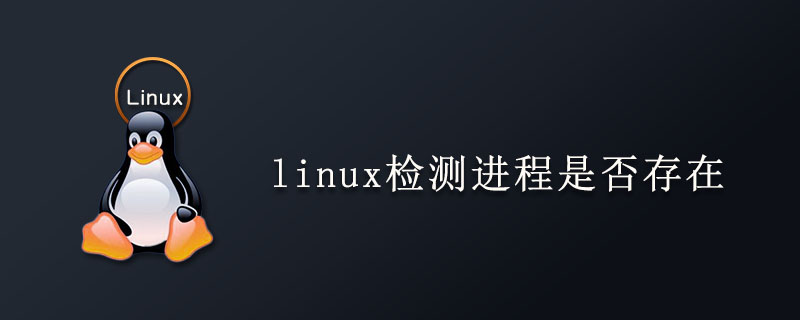 Operation and Maintenance
Operation and Maintenance
 Linux Operation and Maintenance
Linux Operation and Maintenance
 linux detects whether a process exists
linux detects whether a process exists
linux detects whether a process exists

Detecting whether the process exists under Linux (Recommended learning: linux operation and maintenance)
This problem seems to be very Simple, "ps -ef | grep xx"just do it! Of course you can do this, but if we consider performance, this may not be a good idea.
Suppose we now want to monitor whether a process is alive. Check it every minute. Using the above method, we need to run the ps command every minute and do a grep regular search. This overhead seems to be nothing on the server, but what if we want to monitor dozens or hundreds of such processes on the same node at the same time?
So, we need to explore some better methods from a performance perspective.
For daemon processes, they usually have their own pid or lock files. We can check whether these files exist to determine whether the process exists. However, under some abnormal circumstances, the process where the pid file exists does not exist. Therefore, you cannot rely on the process's pid file to detect whether the process is alive.
A reliable method is to use "kill -0 pid", kill -0 will not send any signal to the process, but will do error checking. The command returns 0 if the process exists and 1 if it does not exist.
[sw@gentoo ~]$ ps PID TTY TIME CMD pts/0 00:00:00 bash pts/0 00:00:00 ps [sw@gentoo ~]$ kill -0 15091 [sw@gentoo ~]$ echo $? [sw@gentoo ~]$ kill -0 15092 -bash: kill: (15092) - No such process [sw@gentoo ~]$ echo $? [sw@gentoo ~]$
However, this method can only be used for ordinary users to check their own processes, because sending signals to other users' processes will cause an error due to lack of permission, and the return value is also 1.
[sw@gentoo ~]$ kill 2993 -bash: kill: (2993) - Operation not permitted [sw@gentoo ~]$ echo $? 1 [sw@gentoo ~]$
Of course, if you use a privileged user to execute the kill command, there will be no permission problem.
The above is the detailed content of linux detects whether a process exists. For more information, please follow other related articles on the PHP Chinese website!

Hot AI Tools

Undresser.AI Undress
AI-powered app for creating realistic nude photos

AI Clothes Remover
Online AI tool for removing clothes from photos.

Undress AI Tool
Undress images for free

Clothoff.io
AI clothes remover

Video Face Swap
Swap faces in any video effortlessly with our completely free AI face swap tool!

Hot Article

Hot Tools

Notepad++7.3.1
Easy-to-use and free code editor

SublimeText3 Chinese version
Chinese version, very easy to use

Zend Studio 13.0.1
Powerful PHP integrated development environment

Dreamweaver CS6
Visual web development tools

SublimeText3 Mac version
God-level code editing software (SublimeText3)

Hot Topics
 1664
1664
 14
14
 1422
1422
 52
52
 1316
1316
 25
25
 1268
1268
 29
29
 1241
1241
 24
24
 Linux Architecture: Unveiling the 5 Basic Components
Apr 20, 2025 am 12:04 AM
Linux Architecture: Unveiling the 5 Basic Components
Apr 20, 2025 am 12:04 AM
The five basic components of the Linux system are: 1. Kernel, 2. System library, 3. System utilities, 4. Graphical user interface, 5. Applications. The kernel manages hardware resources, the system library provides precompiled functions, system utilities are used for system management, the GUI provides visual interaction, and applications use these components to implement functions.
 How to check the warehouse address of git
Apr 17, 2025 pm 01:54 PM
How to check the warehouse address of git
Apr 17, 2025 pm 01:54 PM
To view the Git repository address, perform the following steps: 1. Open the command line and navigate to the repository directory; 2. Run the "git remote -v" command; 3. View the repository name in the output and its corresponding address.
 vscode Previous Next Shortcut Key
Apr 15, 2025 pm 10:51 PM
vscode Previous Next Shortcut Key
Apr 15, 2025 pm 10:51 PM
VS Code One-step/Next step shortcut key usage: One-step (backward): Windows/Linux: Ctrl ←; macOS: Cmd ←Next step (forward): Windows/Linux: Ctrl →; macOS: Cmd →
 How to run java code in notepad
Apr 16, 2025 pm 07:39 PM
How to run java code in notepad
Apr 16, 2025 pm 07:39 PM
Although Notepad cannot run Java code directly, it can be achieved by using other tools: using the command line compiler (javac) to generate a bytecode file (filename.class). Use the Java interpreter (java) to interpret bytecode, execute the code, and output the result.
 What is the main purpose of Linux?
Apr 16, 2025 am 12:19 AM
What is the main purpose of Linux?
Apr 16, 2025 am 12:19 AM
The main uses of Linux include: 1. Server operating system, 2. Embedded system, 3. Desktop operating system, 4. Development and testing environment. Linux excels in these areas, providing stability, security and efficient development tools.
 How to run sublime after writing the code
Apr 16, 2025 am 08:51 AM
How to run sublime after writing the code
Apr 16, 2025 am 08:51 AM
There are six ways to run code in Sublime: through hotkeys, menus, build systems, command lines, set default build systems, and custom build commands, and run individual files/projects by right-clicking on projects/files. The build system availability depends on the installation of Sublime Text.
 laravel installation code
Apr 18, 2025 pm 12:30 PM
laravel installation code
Apr 18, 2025 pm 12:30 PM
To install Laravel, follow these steps in sequence: Install Composer (for macOS/Linux and Windows) Install Laravel Installer Create a new project Start Service Access Application (URL: http://127.0.0.1:8000) Set up the database connection (if required)
 git software installation
Apr 17, 2025 am 11:57 AM
git software installation
Apr 17, 2025 am 11:57 AM
Installing Git software includes the following steps: Download the installation package and run the installation package to verify the installation configuration Git installation Git Bash (Windows only)



